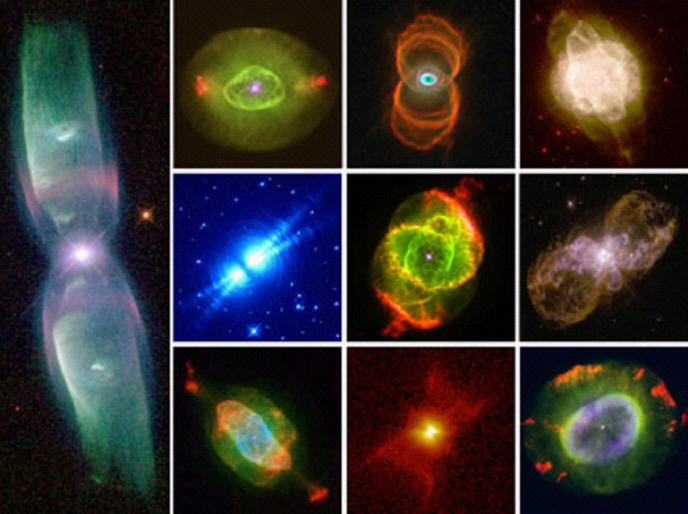|
|
Which Nebula is Real?
Oct 14, 2009
What is a theory? What is
science? What is reality?
Doing philosophy is like sculpting
fog. The abstractions to be
investigated have ambiguous and
shifting forms, and their traces are
the vortices left by human thought
in evening mists. Most scientists
most of the time are well-advised to
eschew it. It has little relevance
for working within the boundaries of
accepted theories.
However, the history of science
shows that progress involves long
stretches of development couched
within boundaries that are
interrupted by episodes of theory
change. During the quiet times,
accumulating data and modified
ideas, along with new instruments
and many other influences, push
scientists toward the boundaries.
They begin to trespass beyond them.
Outside the boundaries, the fog
sculptures come alive and bite. Some
theories go extinct; others
proliferate and come to dominate the
scientific ecosystem. Careers
change. Textbooks are replaced.
Grants go to other projects.
For the astrophysicist, an electron
is a particle of matter with
momentum that is described in part
by Newton’s laws. It goes “bump” in
the night sky and causes shock waves
and hot gas in planetary nebulae.
The nebulae are explosions of stars
that are burning themselves up with
internal fusion fires.
For the plasma physicist, an
electron is a unit of charge in an
electrical current that is described
in part by Maxwell’s equations. It
is part of an electrical circuit
that causes planetary nebulae to
emit synchrotron radiation, to show
bipolar symmetry, to have hourglass
shapes, to develop toroidal currents
around the central star, to display
polar jets, and to oscillate in
energy output. The nebulae are
z-pinches in galactic electrical
circuits.
So what is an electron, really? What
is a planetary nebula, really? As
long as the two physicists stay
inside the boundaries of their
respective theories, the questions
don’t arise. The answers are
presumed by each theory’s axioms of
what is real. The criteria of
acceptability for each theory (What
constitutes evidence? What
constitutes an explanation?) don’t
apply to the other theory.
Cross-theory debates can only end in
pleonastic proclamations of what is
“really real”: “Is not!” “Is too!”
Outside the boundaries, the two
theories meet in an evolutionary
survival landscape: It’s a jungle
out there. Criteria of selection are
extra-scientific. The question
becomes one of market share. How
many people are attracted by the
promise of a new theory? How many
become curious about things that a
new theory might enable them to do?
How many are bored with the old one
and feel that its labyrinthine
adjustments to novel data and ideas
are a nuisance?
Philosophers worry about how there
can be progress toward understanding
a hypothetical ultimate reality when
the history of science is a
succession of contradictory
theories, each of which was
considered “real” in its heyday.
Progress can be understood in other
than teleological terms: Biologists
understand evolution as a bush that
grows bigger at each season but has
no “final form” that predetermines
each season’s growth. In the same
way, the progress of science doesn’t
need the hypothesis of ultimate
reality.
Each theory can have its time to be
real, to be a “best fit” within a
larger intellectual ecosystem,
without having to live forever. The
electron as particle and the nebula
as explosion have been useful
theories. Eventually, there comes a
time when it’s just time to die.
Mel Acheson
|
|
|
|
|
|
SPECIAL NOTE - **New Volumes Available:
We are pleased to announce a new
e-book series
THE UNIVERSE ELECTRIC. Available now, the first volume
of this series, titled Big Bang, summarizes the failure of modern cosmology
and offers a new electrical perspective on the cosmos. At
over 200 pages, and
designed for broadest public appeal, it combines spectacular
full-color graphics with lean and readily understandable
text.
**Then second and third volumes in the series are now available,
respectively titled Sun and Comet, they offer
the reader easy to understand explanations of how and why these bodies
exist within an Electric Universe.
High school and college students--and teachers in
numerous fields--will love these books. So will a large
audience of general readers.
Visitors to the Thunderbolts.info site have often
wondered whether they could fully appreciate the Electric
Universe without further formal education. The answer is
given by these exquisitely designed books. Readers from
virtually all backgrounds and education levels will find them
easy to comprehend, from start to finish.
For the Thunderbolts Project, this series is a milestone.
Please see for yourself by checking out the new
Thunderbolts Project website, our leading edge in
reaching new markets globally.
Please visit our
Forum
|
|
|
|
|
|
|
|







